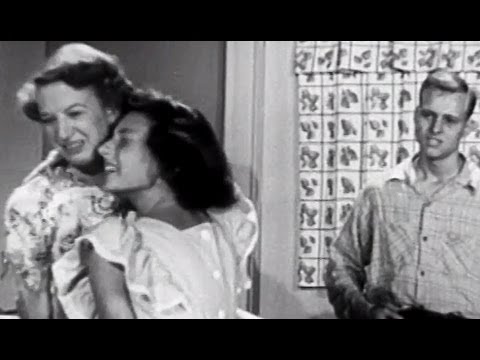more at:
‘Well-balanced emotions help to create a well-rounded personality, especially in teenagers…
ILLUSTRATES NEED FOR WELL-BALANCED EMOTIONS IN A WELL-ROUNDED PERSONALITY. GREAT SEQUENCE OF PSYCHOLOGIST WHO PUTS TOGETHER BUILDING BLOCKS OF EMOTIONS & COVERS IT ALL WITH METAL CIRCLE OF “PERSONALITY”.
Ken Smith sez: This bizarre film is hosted by an unnamed “psychologist.” While spouting Pavlovian claptrap such as “Fear is triggered by loud noises” and “Your emotions can be your own greatest enemy,” he repeatedly interrupts the story of “Jeff,” the film’s protagonist. Jeff — who looks like a heroin addict — has a lot of trouble controlling his emotions, and the psychologist is always ready to pop in with statements such as “If this kind of behavior is repeated often, it might lead to a permanently warped personality.”
Control Your Emotions doubles as a lesson in behaviorist psychology and an admonition to postwar American children. “Before man learned how to control fire and put it to work, it was man’s greatest enemy. In much the same way, your emotions can be your own greatest enemy.” Similar messages percolate throughout the social guidance films of the 1940s and 1950s (see, for example, A Date With Your Family on The Behavior Offensive disc, where the narrator intones, “Pleasant, unemotional conversation helps the digestion”).
The links between the effort to manage and regulate outbursts of feeling and the national offensive to smooth out adolescent behavioral excesses often seem obscure. There is no doubt, however, that the architects of Fifties consensus (psychologists, educators, the judiciary, sociologists and advertisers) wished to discourage “unproductive” and negativistic behavior. “Severe emotional stress,” says the narrator of this film, “often decreases efficiency.” As the film Office Courtesy (on this disc) shows, carefully regulated behavior was a condition of admission to the white-collar workplace. Perhaps Jeff, the short-fused antihero of Control Your Emotions, is simply undergoing the behavior modification required in order to become a middle manager.
What seems clearest is that for Americans, recovery from wartime damage was more about drawing away emotionally from war’s stresses and strains than digging graves and sweeping up rubble. After twelve years of economic depression and almost four years of world war, parents (and the authorities on child development that stood behind them) wanted a peaceful and disruption-free world for their kids, and they don’t seem to have distinguished between internal and external turmoils. All were undesirable.
Responsive both to the demands of the era and the process of individual maturation, Control Your Emotions ultimately promoted social adaptation over self-expression. It assumed that kids’ behavior was a vehicle for emotions that were essentially uncomplicated, individual rather than social. In its scheme, teenagers’ emotions weren’t linked with any cultural or social contradictions, but simply combinations of the three basic emotions: rage, fear and love. So while other Coronet films like Shy Guy (see The Behavior Offensive) hinted at the existence of a youth culture with its own rewards and pressures, Control Your Emotions saw teens more as creatures of their hormones than of their times.
The original script, on file at the Library of Congress, offers interesting insight into the means by which the film was supposed to work. Most revealing are the character descriptions:
“JEFF. About 17. Heavy part. Quick, vivid temper. Hyper-thyroid type, perhaps. Must show rage in face – see script in detail. Should look tall and strong.
“ROGER. Perhaps 10-12. Must show fear – heavy, sobbing fear. Playful, mischievous.
“MOTHER. 35-40. Must be a little woman to contrast in size with JEFF. On her face we must see fear, anger, and affection.
“JOAN. 13-14, Slightly ‘brattish’ adolescent. Capable of exuberant enthusiasm. Not a major part.
“DOCTOR. 40-50, pleasant, narrator type – speaks to camera – white coat.”‘
NEW VERSION with improved video & sound:
Public domain film from the Prelinger Archives, slightly cropped to remove uneven edges, with the aspect ratio corrected, and mild video noise reduction applied.
The soundtrack was also processed with volume normalization, noise reduction, clipping reduction, and/or equalization (the resulting sound, though not perfect, is far less noisy than the original).

